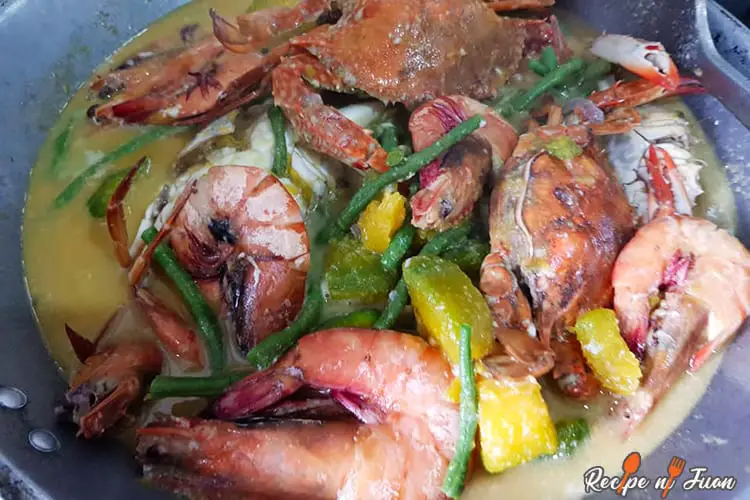Ginataang Hipon, Sitaw at Kalabasa (shrimp, string beans, squash)
A tropical country like the Philippines will never be in want of coconut trees, as it is literally everywhere in the archipelago.
So, it is not really surprising that we have several dishes with coconut milk or “gata” as its main ingredient.
Though gata is commonly associated with the Bicol region as coconut palm trees are abundant in the area, a lot of Filipinos also use gata in their recipes regardless of their region.
Ginataang Hipon, Sitaw at Kalabasa (Shrimp, String beans and squash in coconut milk stew) is another one of those recipes that use coconut milk in its list of ingredients.

A one-pot dish, this ginataang hipon, sitaw, and kalabasa recipe is pretty straightforward once you’re done squeezing the milk from the coconut.
Speaking of the gata, if you are from the provinces, this is especially easy to acquire.
However, for those of you in the cities, you can either get coconut milk from the wet market (ask the vendor to squeeze out the milk from the shredded coconut meat for you or you can do it yourself if you have a “pangkayod” or shredder) or buy it from the supermarket.
Also read: how to make ukoy spicy shrimp

Check out our new cookbook
Bitemybun's family recipes with complete meal planner and recipe guide.
Try it out for free with Kindle Unlimited:
Read for freeIn this post we'll cover:
Ginataang Hipon, Sitaw at Kalabasa Preparation Tip
- As for the shrimp, you can toss it in, head, skin and all, or you can uncover the shrimp and cook it in the same way. However, we suggest that you keep the shrimp’s skin in as it is going to make eating this ginataan dish a little bit messy but in a good way.
- The squash and the string beans come in last especially if you want to have that crunch while eating the dish.
- As for the side dips and condiments, you can have the dish partnered with bagoong alamang to be put on top of it or to be mixed into the dish. You can also have bagoong isda and patis.

Ginataang Hipon, Sitaw at Kalabasa Recipe
Ingredients
- 1 tbsp vegetable oil
- 1 cup chopped onion
- 3 tbsp minced garlic
- 3 pcs green chili
- 1 lb shrimp peeled and deveined
- 3 cups peeled and cubed squash (kalabasa)
- 2 cups string beans (sitaw) cut into 2 1/2″ length
- 1 tbsp maggi magic sarap
- 1½ cups coconut milk
- 2 tbsp fish sauce
- ½ tsp ground black pepper
Instructions
- In a skillet saute chopped onion and minced garlic in oil over a medium heat and stir frequently until the onions are browned and the garlic is fragrant.
- Add the peeled and cubed kalabasa and simmer for 5 minutes. Stir in shrimp and sitaw, then continue cooking for another 3 minutes adding fish sauce, pepper, and Maggi magic sarap.
- Pour in the coconut milk into the skillet, bring it to a boil and then add the green chili. Cover the skillet and continue simmering until vegetables are cooked and coconut milk becomes a little thick.
- Served hot with steamed rice. Share & enjoy!
Notes
Nutrition

Learn how to make another delicious shrimp recipe: camaron rebosado with bread crumbs
Enjoy!
Check out our new cookbook
Bitemybun's family recipes with complete meal planner and recipe guide.
Try it out for free with Kindle Unlimited:
Read for freeJoost Nusselder, the founder of Bite My Bun is a content marketer, dad and loves trying out new food with Japanese food at the heart of his passion, and together with his team he's been creating in-depth blog articles since 2016 to help loyal readers with recipes and cooking tips.
